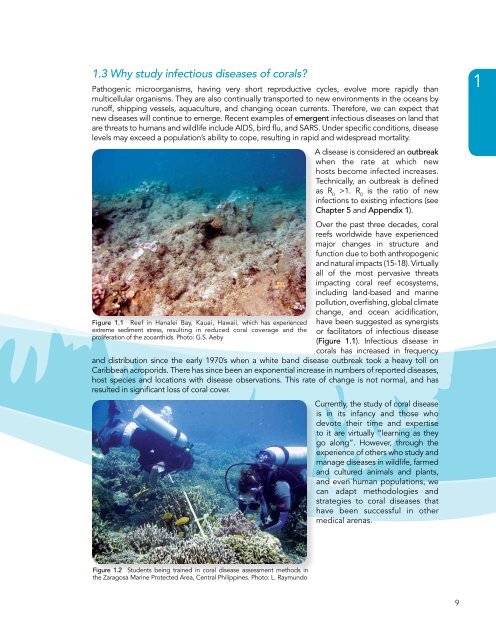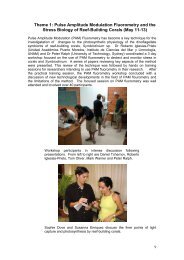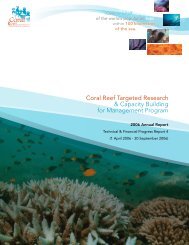A <strong>Coral</strong> <strong>Disease</strong> <strong>Handbook</strong>:Guidelines for Assessment, Monitoring and ManagementThe Objectives and Scope of This ManualL. Raymundo and C. D. Harvell1.1 The state of coral reefs and the purpose of this manual<strong>Coral</strong> reefs are the most diverse and among the most productive ecosystems on earth. Millions ofpeople directly rely on the harvest derived from coral reefs as their major source of protein and income.In addition, the revenue coral reefs earn from tourism, recreation, education and research is of majorimportance to their local and national economies. And finally, current research in such areas as naturalproducts chemistry suggest that coral reefs support an unknown number of organisms that may prove tobe of major benefit in the treatment of critical human diseases. Yet, in spite of their obvious importance,reefs continue to be impacted by “the big four” human activities that threaten their sustainability:climate change, land- and marine-based pollution, habitat degradation and over-fishing.Many of these impacts have obvious and immediate effects, such as smothering or fragmentation ofcoral to the point of total mortality. However, some effects, such as those from chemical pollutants,waste or excess nutrients, are more insidious, and their impacts may be more difficult to understandand quantify. One phenomenon which has recently gained the attention of coral reef scientists andmanagers is disease. <strong>Disease</strong>s affecting corals, particularly in the Caribbean, have increased in bothfrequency and severity within the last three decades and caused major community shifts on Caribbeanreefs. Yet we are only beginning to understand enough about drivers of disease outbreaks to considermanagement actions.While diseases affecting corals have increased since the 1970’s, there are few individuals throughoutthe world trained to recognize diseases on coral reefs. In addition, there are many areas where thereis absolutely no information regarding the status of coral health and disease.Written for coral reef managers, this manual aims to fill the knowledge gap by bringing togetherwhat is currently known about coral diseases, how they are studied, and what options are availablefor managing them. We first present some general concepts about disease to put this manual and itsscope in perspective. We then present the most current descriptions of known coral diseases, withinformation to assist in their field identification. Subsequent chapters are devoted to confirming fieldidentifications, quantifying impacts of disease to coral communities, assessing disease on reefs, andsetting up monitoring programs. We then provide information as to what is currently understoodregarding disease outbreaks and how to track and study them. We end with guidelines on managementpractices and suggestions for where to obtain further information and direction.Included in the appendices are categories of additional information which we hope will be useful.Underlined terms throughout the text indicate words listed in the glossary in Appendix 1.81.2 What is disease?<strong>Disease</strong>s are a natural aspect of populations, and are one mechanism by which population numbersare kept in check. For the purposes of this manual, we will use the term disease to mean “anyimpairment to health resulting in physiological dysfunction”. <strong>Disease</strong> involves an interaction betweena host, an agent, and the environment. The focus of this manual is infectious biotic diseases; thosethat are caused by a microbial agent, such as a bacterium, fungus, virus, or protist, that can be spreadbetween host organisms and negatively impact the host’s health. Other forms of disease that impactcorals may be considered abiotic diseases; they do not involve a microbial agent but impair health,nonetheless. Examples may be those caused directly by environmental agents such as temperaturestress, sedimentation, toxic chemicals, nutrient imbalance and UV radiation. In addition, noninfectiousbiotic diseases are not transmitted between organisms, though they may be caused by a microbialagent. For example, certain microbes secrete a toxin which damages the host animal or plant.A good example of this is botulism; toxins released by the bacterium Clostridium botulinum cause anon-infectious but deleterious disease in organisms that consume it.
1.3 Why study infectious diseases of corals?Pathogenic microorganisms, having very short reproductive cycles, evolve more rapidly thanmulticellular organisms. They are also continually transported to new environments in the oceans byrunoff, shipping vessels, aquaculture, and changing ocean currents. Therefore, we can expect thatnew diseases will continue to emerge. Recent examples of emergent infectious diseases on land thatare threats to humans and wildlife include AIDS, bird flu, and SARS. Under specific conditions, diseaselevels may exceed a population’s ability to cope, resulting in rapid and widespread mortality.Figure 1.1 <strong>Reef</strong> in Hanalei Bay, Kauai, Hawaii, which has experiencedextreme sediment stress, resulting in reduced coral coverage and theproliferation of the zooanthids. Photo: G.S. AebyA disease is considered an outbreakwhen the rate at which newhosts become infected increases.Technically, an outbreak is definedas R 0>1. R 0is the ratio of newinfections to existing infections (seeChapter 5 and Appendix 1).Over the past three decades, coralreefs worldwide have experiencedmajor changes in structure andfunction due to both anthropogenicand natural impacts (15-18). Virtuallyall of the most pervasive threatsimpacting coral reef ecosystems,including land-based and marinepollution, overfishing, global climatechange, and ocean acidification,have been suggested as synergistsor facilitators of infectious disease(Figure 1.1). Infectious disease incorals has increased in frequencyand distribution since the early 1970’s when a white band disease outbreak took a heavy toll onCaribbean acroporids. There has since been an exponential increase in numbers of reported diseases,host species and locations with disease observations. This rate of change is not normal, and hasresulted in significant loss of coral cover.Currently, the study of coral diseaseis in its infancy and those whodevote their time and expertiseto it are virtually “learning as theygo along”. However, through theexperience of others who study andmanage diseases in wildlife, farmedand cultured animals and plants,and even human populations, wecan adapt methodologies andstrategies to coral diseases thathave been successful in othermedical arenas.1Figure 1.2 Students being trained in coral disease assessment methods inthe Zaragosa Marine Protected Area, Central Philippines. Photo: L. Raymundo9








